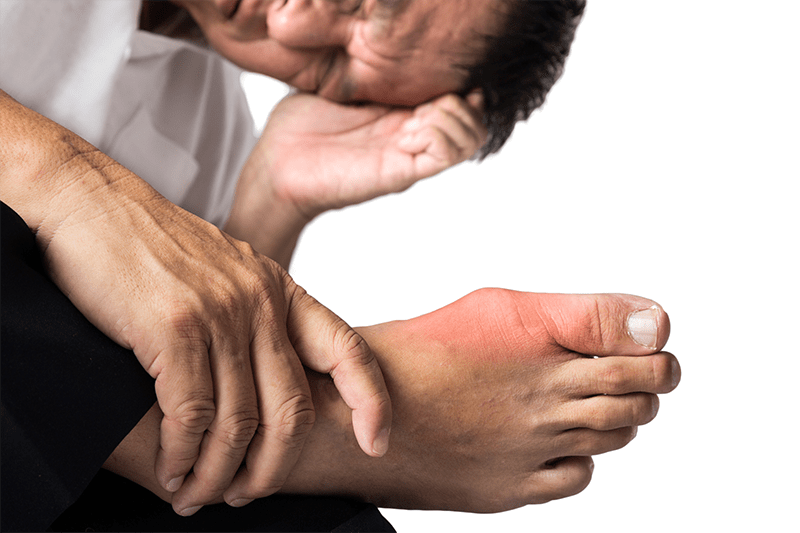Gout can come like a thief in the night. Suddenly, you feel excruciating soreness, probably in your big toe. You may even feel like you have a fever. Gout and joint pain go hand-in-hand, and it’s a very distressing condition to find yourself in. It is also a condition that is often misunderstood. We are going to go over what exactly gout is and how it relates to joint soreness. Then, we will look at a few ways you can relieve gout and joint pain naturally.
What Is Gout?
Gout is a form of arthritis, albeit a complex version of it. It usually affects people who are overweight, although it can affect anyone. Symptoms of gout include the following:
- Severe joint pain, especially in the big toe, but also the ankles, knees, elbows, wrists, and fingers.
- Lingering and subtle soreness after sudden severe bouts of pain subside. Pain can linger for days or even weeks. Subsequent attacks involve more joints and will last longer.
- Inflammation, tenderness, swelling, and redness in the affected joints.
- Reduced mobility, especially as gout progresses.
Any of these symptoms may come and go sporadically. The most intense pain will occur between the initial 4-12 hours after the first attack is experienced.

What Causes Gout?
The cause of gout and joint pain associated with it is unique among other issues leading to joint pain. What happens is urate crystals build up within certain joints. These crystals lead to inflammation and soreness, given how abrasive they are to the surrounding areas they end up in.
The cause of these urate crystals is the existence of a high level of uric acid within a person’s blood. The reason for these elevated levels of uric acid is due to the body breaking down purines, which are found in all living things, and are naturally-occurring within the body. Purines also show up in higher quantities in certain foods, including steak, seafood, and others.
Also, there are foods containing higher levels of uric acid, including beer, drinks with added fructose, and more. Uric acid is usually not a problem, since the body has an efficient way of dissolving it within the bloodstream and passing it through the kidneys, eventually coming out as urine. However, there are times when the body will produce too much uric acid. Alternatively, the kidneys may not excrete the amount of uric acid that they should. When either of these happens, it can result in a build-up of sharp needle-like urate crystals. These crystals tend to develop where joints are located. Once there, they poke the tissue in the area and lead to feeling excruciating pain, as well as swelling.
Who Is at Risk of Developing Gout?
Some people are more likely to develop gout than others. Those who have higher levels of uric acid in their bodies will see their chances of developing gout skyrocket. There are also a number of other factors that can increase the likelihood of experiencing gout. These include the following:
Eating Certain Foods
Eating plenty of organ meats, steak, and seafood can increase the chances of developing gout. Drinking beverages containing a great deal of fruit sugar, as well as alcohol, also increases the likelihood of gout and joint pain developing.

Being Overweight
Obesity is a leading contributing factor to the development of gout and joint pain. You increase the likelihood of succumbing to this condition if you are overweight. This is due to the body producing more uric acid when you are obese, leading to the kidneys having a harder time disposing of all the uric acid being produced.
Medical Conditions
There are certain conditions that can lead to gout, such as high blood pressure, diabetes, and diseases affecting the heart and kidneys.
Some Medications
There are certain medications, such as those used for treating hypertension, that can elevate uric acid levels in the body. Even something like a small dose of aspirin can do so. More rarely, drugs provided to people who have received an organ transplant will also make their uric acid levels rise.
Hereditary
If there is a family history of gout, a person is more likely to have gout themselves.
Age & Gender
Men are more likely to have gout than women. This is primarily due to women having lower levels of uric acid until at least menopause. The age at which men usually develop gout is between 30-50 years old. Women are more likely to have gout after menopause.
How to Prevent Gout and Joint Pain
If you want to prevent gout and joint pain, or reduce the adverse health effects they bring on, there are a number of actions you can take and changes you can make.
Here are some of the best ways to do so:
Drink More Water
Drink plenty of water to stay hydrated and keep eliminating uric acid.
Reduce or Eliminate Alcohol
Reduce or abstain entirely from alcohol, especially beer.
Eat More Low-Fat Foods
Switch to getting your protein from low-fat dairy foods.
Reduce Consumption of Meat and Seafood
While you do not need to eliminate meat and seafood completely, you should reduce how much you eat.
Reduce Your Weight
If you are overweight or obese, shed some pounds, and then maintain a healthy weight.
Take a Joint Supplement
A joint supplement like JointFuel360 contains potent anti-inflammatory compounds that will reduce the potential for gout and joint pain.
Wrapping Up
Gout and joint pain can be annoying conditions to deal with. With just a few major lifestyle choices, you can reduce the excruciating soreness you may be suffering from. This is an often-misunderstood condition that you hopefully understand a little more clearly now. Make some changes today before your gout takes an even greater toll on your life, and you will be glad you decided to take action now.
